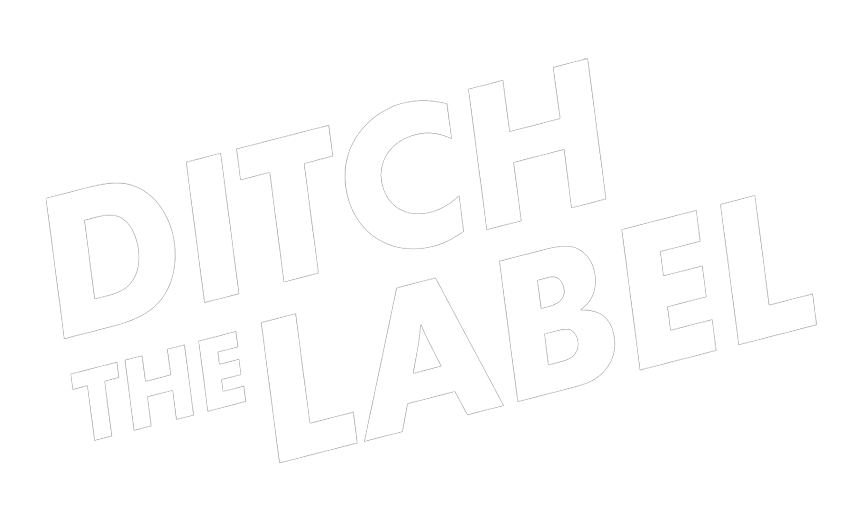Cyberbullying comes in a whole range of different shapes and sizes and is something that is totally subjective to the person being cyberbullied.
From our research on cyberbullying, we found that up to 7 in 10 young people experience cyberbullying before the age of 18.
Ditch the Label defines cyberbullying as the following:
Cyberbullying is the use of digital technologies with an intent to offend, humiliate, threaten, harass or abuse somebody.
– Ditch the Label
We all spend a ridiculous amount of time online. With the internet in your pocket, in school, at work and at home, it is impossible to escape it. That’s why being bullied online can be absolutely rubbish, and can make it feel impossible to live your life. We have put together this so you can understand everything you need to know about cyberbullying and where you can get help if you need it.

What are the different types of cyberbullying?
Examples of cyberbullying include:
- Nasty messages online or on your mobile phone
- Comments or replies on your social media posts or posts about you
- Being excluded from online group chats on purpose
- Embarrassing or harmful photos being put online without your permission
- Sending offensive pictures through a messaging app
- Rumours and lies about you on a website, messaging app or social media platform
- Offensive chat or voice communication on an online game
- Fake online profiles being created with an intent to defame you
If you are experiencing cyberbullying or you know someone who is, check out our Top 9 Tips For Dealing With Cyberbullying or visit our Community to talk to a trained digital mentor who can help you with what to do next.
Are you being Cyberbullied?
Asking yourself the following questions can help you determine whether you’re being cyberbullied:
- Are you on the receiving end of hurtful comments online?
- Is someone persistently bothering you on social media?
- Have you ever been threatened by someone you know online?
- Do people spread gossip or rumours about you on the internet?
- Has a picture of you been shared without your consent?
- Have you been hacked or impersonated online?
- Are you being blackmailed online?
Are you looking to prevent cyberbullying?
Anybody can become a recipient of cyberbullying, regardless of how old they are or the kind of job that they do or what their hobbies might be. It is never anything to do with you.
Learn more
Cyberbullying Statistics
From our research, we found that up to 7 in 10 young people experience cyberbullying before the age of 18.
Taken from The Annual Bullying Survey, Ditch the Label
- 7 out of 10 young people have been victims of cyberbullying.
- 37% of young people have experienced cyberbullying on a highly frequent basis
- 20% of young people have experienced extreme cyberbullying on a daily basis
- Young people are found to be twice as likely to be bullied on Instagram than on any other social network.
- 54% of young people using Facebook reported that they have experienced bullying on the network.
- 28% of young people using Twitter reported that they have experienced bullying on the network.
- Cyberbullying is found to have catastrophic effects on the self-esteem and social lives of up to 69% of young people.
- An estimated 5.43 million young people in the UK have experienced cyberbullying with 1.26 million subjected to extreme cyberbullying on a daily basis.
- New research shows that young males and females are equally at risk.
Taken from The Wireless Report, Ditch the Label
- 37% 13 – 25-year-olds have sent a naked photo of themselves (63% to a boyfriend/girlfriend and 32% to someone they are attracted to)
- 30% of 15 yr olds have sent a naked photo of themselves at least once
- 15% of 13 & 14 yr olds have sent a naked photo of themselves at least once
- 5% of 13-year-olds send naked photos several times a week.
- 24% have sent a naked photo to someone they know only online.
- 24% have had a naked photo shared without their consent.
- 49% believe is just harmless fun.
- 16% said it’s the normal thing to do.
- 13% felt pressurised into doing it.
- Females are twice as likely to send a naked photo of themselves more than once a week than men.
- 62% have been sent nasty private messages via smartphone apps
- 52% have never reported the abuse they have received.
- 47% have received nasty profile comments
- 40% have received nasty photo comments.
- 42% have received hate-based comments (racism, homophobia etc.)
- 28% have had personal information shared without consent.
- 52% have never reported abuse on smartphone apps
- 26% felt like it wasn’t taken seriously when reported
- 49% experienced a loss in confidence as a result of the bullying
- 28% retaliated and sent something abusive back
- 24% turned to self-harm as a coping mechanism
- 22% tried to change their appearance to avoid further abuse
- 13% stopped using the app
What Does The Law Say?
As cyberbullying is a relatively new phenomenon, the UK courts are still trying to catch up with it and sentence offenders effectively. Though no laws specifically apply to cyberbullying alone, there are several laws which can be applied in cyberbullying cases:
- Protection from Harassment Act 1997
- Criminal Justice and Public Order Act 1994
- Malicious Communications Act 1988
- Communications Act 2003
- Breach of the Peace (Scotland)
- Defamation Act 2013
In 2012 The Crown Prosecution Service published guidelines on how cyberbullying cases would be assessed against current laws, which you can find here.
On January 1st 2014, the Defamation Act 2013 came into order and can be read here.
Cyber Bullying Prosecutions
Cyberbullying cases can often go unreported by victims for fear of what people may say, and indeed this was an issue faced by Nicola Brookes, who was remorselessly cyberbullied after posting a message of support on Frankie Cocozza’s Facebook page. After taking evidence to the Police with no success, she took her case to the High Court and won a battle with Facebook to have her bullies’ names revealed. You can read more about the story here. The case was a landmark battle, as for the first time it meant a website had to release members’ details, opening them up for prosecution.
Trolls are increasingly being taken to court and if found guilty, given fines and facing jail terms. Two people who sent abusive messages towards Caroline Criado-Perez were jailed for 8 weeks and 12 weeks and were ordered to pay £800 in fines.
A website owner will generally be responsible for content posted on the website, meaning that if a defamatory comment (or series of comments) exists on a website, the site’s owner can be taken to court – this is how Nicola Brookes was able to get information about her trolls from Facebook. Alternatively, it may be possible to take the troll themselves to court, as has been seen in the case of Caroline Criado-Perez. As with any court case, the evidence is essential and it’s important to catalogue any abuse you may receive. KnowtheNet has produced a helpful infographic on how to interact on the internet, and you can see it here.
On a different note, after boxer Curtis Woodhouse had been trolled by the same account on Twitter for months, he put a bounty on the address of his assailant and visited the troll’s house to solicit an apology from him. Though this isn’t advised, it’s a good example of how cowardly bullies are when the tables are turned.
Reporting Cyberbullying
Reporting Cyberbullying on Facebook
How to report and remove a post
– On the post that you want to report/remove, click on the arrow icon in the top right hand side and select I don’t like this post.
– When the window pops open just click the appropriate reason for removing the post.
– Then you are given the options on how to proceed. You are given plenty of options to choose from.
– Once you have gone through this short process, you will have several options on how to proceed including blocking the person who made the original post and making a complaint to Facebook.
Blocking a User
– You can still block users by going to their Facebook page. Once on their profile page go to the top right corner and click on the button to the right of the messages button.
– You now have the option to report or block them.
Dealing with Abusive Messages
– If you are using the chatbox then click on the options logo in the right corner followed by Report as Spam or Abuse…
– If you are in your inbox, select the message that you want to get rid of or report from the left-hand column by clicking on it.
– Click on Actions at the top of your screen and select Report as Spam or Abuse…
– Three options will appear so just click on the one that is appropriate.
Reporting Cyberbullying on Twitter
Blocking a user through a Tweet
– On the tweet that you want to block, click on the more (…) icon at the bottom of the Tweet and click Block.
Blocking a user through a profile
– Go to the profile page of the user you want to block.
– Click on the options icon next to the follow button and select block.
– You can also report users by completing these same steps.
Reporting Cyberbullying on Instagram
Reporting Content or a User
– Click on the options arrow either on a post or the users profile and click report.
Getting Further Support
Whether you’re being cyberbullied yourself or know somebody that is, help is at hand. Visit our help section for more information or join the Ditch the Label community today.
Research papers
If you want to learn more about bullying-related trends, behaviours and attitudes across the past six years.













